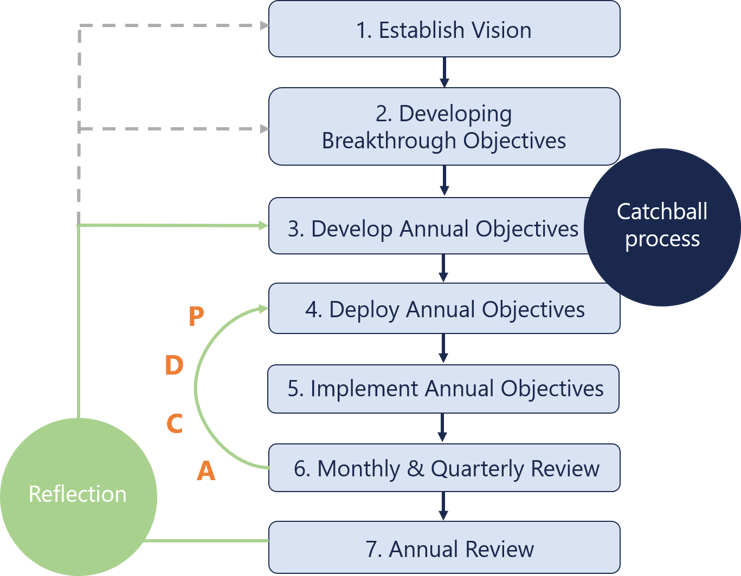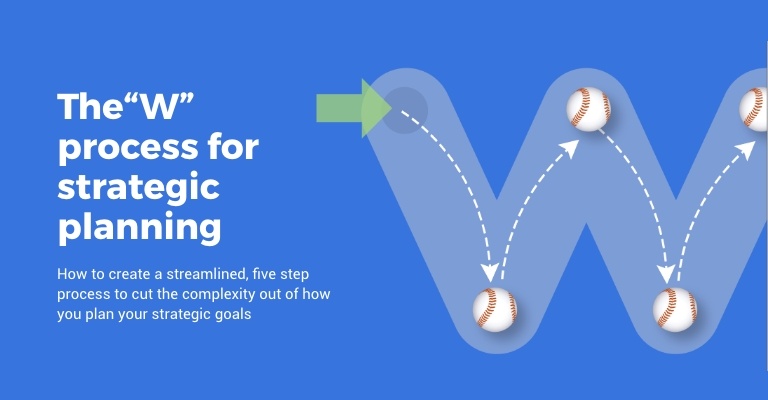Whether a Hoshin expert or novice, running your first or hundredth Hoshin workshop, there are always learning opportunities to be found. Read on to discover how you can prepare for your policy deployment sessions with renewed confidence.
Written by: James Milsom, Head of Marketing
When running a workshop of any kind – whether a Kaizen event or a brainstorming session – proper preparation is the foundation for creating meaningful conversations, learning, and improvements.
With a strategy execution framework such as Hoshin Kanri, you are required to take your business on a journey.
Not only is it a framework transplanted from a different culture, but it is also an approach that requires a truly different mindset from running daily businesses.
This detour from typical thinking around goal setting, plan execution, and performance reviews are one where education, clarity, alignment, and rigor must prevail.
Today, we're exploring how you can run an effective Hoshin Kanri workshop – from preparation to defining session preparation, we’ll demonstrate how you can set yourself up for success, as well as an example session agenda.
What is a Hoshin Kanri workshop?
Let’s begin with what exactly a Hoshin Kanri workshop is.
It is a strategy setting and planning session conducted with a clear strategy execution framework - Hoshin Kanri (or policy deployment) – one of many frameworks available to your business.
Hoshin's origins are found in Japan (which we have covered at length here), but crucially, it is one of several methodologies which link to Peter Drucker’s Management by Objectives.
Hoshin Kanri necessitates your business to think and plan in multiple time frames or horizons:
- 3-5 year horizons are known as breakthroughs, and
- Yearly horizons are annual targets.
This is possible through coordinated planning, collaboration, and execution across your business.
With a bottom-up and top-down approach to strategy, there will inevitably be an array of stakeholders with different titles, views, and responsibilities involved in this approach.
To this end, the Hoshin workshop looks to bring these people in one direction and set a course for a truly transformative period.
Today's blog is focused on how to succeed with a Hoshin Kanri planning session. The content is based on our "W" process for strategic planning webinar, which can be viewed below.
Why run a Hoshin Kanri planning session?
The sheer scale of change you are embarking on will create learning opportunities and, equally, times of conflict.
Crucially, Hoshin is a framework that delivers tools and creates a mindset where every action is a chance for success.
A Hoshin policy deployment workshop brings your stakeholders from the C-suite, Heads of, team leaders, and subject matter experts into one location (virtual or physical).
It's a starting point for a shared understanding of what is set to be achieved, why, and how this will be realized.
By delivering Hoshin workshops over a defined period, you can look to overcome the typical failings of strategy execution, namely:
- Resistance to accountability
- Firefighting
- Fear of failure
- Analysis paralysis
These typical players can, and often do, derail a strategy.
When goals are poorly defined or lack owners, shrugging shoulders abound.
When daily tasks overwhelm the bigger picture, the path ahead is lost.
When failures are chastised and ridiculed, success is limited.
When data is ignored or overanalyzed, decisions aren’t forthcoming.
To avoid these blockers, we recommend following a planning format such as this:
- Follow a process
- Prepare for the session
- Determine attendees
- Define participation
With rigor and enthusiasm, you can set your deployment off to a strong start – and what follows is our advice on doing so.
1. Follow a process
Processes provide structure and a repeatable path to follow for future use.
When running a Hoshin Kanri workshop, there is little else you can do to set yourself up for success more than defining and following a process.
And that process needn’t be convoluted.
To that end, consider these issues when defining your Hoshin process:
a) Why is the session needed?
A fundamental question that must be asked by yourself, and inevitably will be by your colleagues – why is this Hoshin session necessary?
It is for you, or the facilitator, to explain the value of Hoshin and why a session such as this will provide a clean slate for moving forward with the Hoshin mindset.
If the why is not explained, nor in a way that strikes a chord with your audience, this can be a major initial hurdle.
b) Who should attend?
With clarity over the why you must set about determining the different people that should be present.
Determining who can be achieved through a stakeholder mapping exercise, for example, providing an archetype to each role, and then, in future sessions, you can map individuals to the archetype.
c) What is the agenda?
This is where you must follow some rigor in the sense of Hoshin.
The 7 steps of Hoshin are well defined, offer a solid foundation for the agenda, and give credence to the Hoshin workshop being a series of days, not too dissimilar to a Kaizen event:

As our example will show, this truly is a sound starting point for your agenda. Hoshin Kanri borrows from Lean and Kaizen, given its emphasis on failing fast and forward, so the 7 steps are a natural relative of these methods.
With the addition of education and practical demonstrations, you can follow a tried and true formula.
d) What are the expectations?
Lastly, think about the expectations that you have of the session in terms of behavior and the outcomes.
What does the business want from this time? What should the participants and their dependents want from attendance?
Treat the session fairly and honestly, and your participants will follow suit.
However, do not expect the session to follow your entire process. Sometimes there is value to be found in the unplanned.
2. Preparing for the session
The second suggestion is that you should thoroughly prepare.
With your process set, preparation turns to the logistical realities of the Hoshin session.
Set out to answer some fundamental questions:
a) How long will this session be?
The session duration is a key factor to be considered. Do novices surround you, or are they seasoned Hoshin veterans?
How many participants are planned? If there are small numbers, can the session be just one – or, if there are higher numbers of participants, do you need to break off into smaller groups and/or run the sessions over multiple days?
b) What is the depth of the session?
Intertwined with the question of duration, depth is a matter to be addressed.
Are we creating a Hoshin for the corporate (L0) and divisional level only (L1), or is this something much bigger?
The depth of your Hoshin can have ripple effects, so consider this seriously.
Hoshin plans that attempt to deploy at multiple levels beyond typically 2 / 3 are prone to overcomplication and will see poor execution as more stakeholders set out to conduct their strategies in this new framework.
c) Where should the workshop be hosted?
One of the many unforeseen transformations brought on by COVID-19 was the rise of remote working. Suddenly, work typically undertaken in person was done so behind a laptop in the comfort of our homes.
While the future is likely to be a hybrid between in-person and remote working, the locale of your Hoshin workshop is a matter you must resolve.
If the session is in person, you would be best served with a non-office-based setting to, at least psychology, promote separation of the past from the future.
Enabling remote participation can bring invaluable stakeholders into the session who, without this technology, wouldn’t be able to. Conversely, technology can be temperamental and limit the types of engagement possible in such a session.
The where of your session is a judgment call only you and your business can make.
3. Determine attendees
When speaking of the Hoshin workshop process, stakeholders were introduced as key players in the make-up of your session.
This is because your participants are the lifeblood of the workshop.
Having too many senior leaders present or team leaders will create an echo chamber of a bottom-up or top-down mentality. Likewise, stakeholders representing one area of the business more than another will limit lateral thinking.
A strategy planning workshop such as that in question is significant. The outcomes of this session will set your business on a new course with a clear strategy deployment path - the stakes truly are high.
Your attendees should be made up of:
- Head of Strategy / Transformation / Lean
- Strategy / Transformation / Lean Managers
- Divisional leaders
- Subject matter experts
- Project management team members
- A facilitator
- An executive sponsor
- A champion who believes thoroughly in your approach
- A disruptor who can be a catalyst for mindset changes in your wider business
How you determine who these people are can be challenging. Defining your stakeholders can be done so through a mapping process or using something such as the AIM CAST framework.
With stakeholders mapped, you can understand their drivers, and expected behaviors and ensure that your session is pitched in a manner that provides value to all attendees.
Lastly, please remember that you cannot do everything alone. Use a facilitator, a champion, and project management team members to support you through this process.
4. Define participation
The last area to consider is participation. This is split between pre-event participation and intra-event participation.
Pre-event participation is where it is your role to share the agenda and purpose behind the session to set the tone for what is coming up. It is at this time you can share the following:
- A copy of the business’ mission, vision, and policies
- A Hoshin primer to explain the framework
You can also ask your participants to think critically about their, their team’s, and the business' strengths and weaknesses, alongside their knowledge about the competition, market, and other external factors such as the economy.
Intra-event participation is about setting out the boundaries in which the sessions will unfold. They promote engagement, openness, constructive honesty, and, above all else, stress the importance of challenging current means and ways of operating.
An example Hoshin workshop structure
With the above suggestions in mind, here is an example of how your agenda can unfold when running your Hoshin workshop:
Introductions
a) Introduce Hoshin Kanri
Define its origins and purposes and how it differs from daily management, improvement methodologies, and OKR.
b) Define the expectations
Why are we here today, the behaviors everyone must exhibit, and the outcomes wanted?
Make this participatory and ask attendees to give their views.
c) Be realistic
Spend time speaking to the benefits and challenges we're about to experience with Hoshin Kanri, but focus on the tangible value it’ll bring.
Critical thinking
a) Hoshin Kanri planning horizons
- Breakthroughs (3-5 years)
- Annual (12-18 months)
Explain the planning cycles involved in Hoshin and the philosophical differences between stretching your business beyond its current state (breakthroughs) and front-loading annual achievement to get to that breakthrough.
b) Separating transformation from daily activities
Spend time explaining how Hoshin necessitates harmony between daily activity, improvement projects, and strategic initiatives. This will inevitably require resource allocation and ongoing conflict management under the remit of the PMO. Utilizing your prioritization framework, or indeed building one, will help.
c) Voice of the customer
Fine-tune your participants’ thinking beyond what they see as valuable and align it to what your customers find valuable.
The result is a shifting of goal setting and projects to deliver better experiences and products to your customers.
Hoshin tools
With the foundational elements of Hoshin set out, it is time to explore the different tools available to your participants.
Explain what each of these tools represents and provide an example and supporting material to succeed, such as that available in our Hoshin resource hub:
Leading Hoshin
Hoshin Kanri is a change in the way that many of your participants will go about planning and executing their strategy. While they are learning, it is also a tremendous opportunity for these people to become Hoshin leaders.
In this stage, it is important to cover what makes a strong leader in this regard, covering topics such as:
- Goal alignment and communication
- Learning from failure
- Roadblock identification and overcoming
- Agility – scanning and planning your strategic initiatives regularly
7 steps process
The cultural and theoretical necessitates have been covered by this stage, and therefore it now turns to the practical execution of your Hoshin.
Whether this is the execution of the 7 steps of Hoshin or a simulation event, it will ensure that your first year of Hoshin is set against the well-defined steps.
Going beyond the session
Today's overview has focused greatly on the pre and in-session activities when deploying your Hoshin policy.
That is for good reason.
By spending time planning and following a process for a Hoshin workshop, you are providing your entire organization with a foundation to find success with its strategic goals.
What follows beyond the Hoshin Kanri workshop is simple - executing initiatives that support your goals, measuring these, and learning from successes and failures.
Do not underestimate the importance of this workshop, and that decision will put you in good stead.
For more on planning a successful Hoshin Kanri planning session, watch our "W" process webinar.
Learn more about Hoshin Kanri
Click here to learn more about the Japanese strategy execution method of Hoshin Kanri, or take a look at these content recommendations:
- Leading strategy execution: Strategy execution comes with great responsibilities, which calls for an even greater leader. Strategic leaders are the captain of your organizational ship, which is why they are central to the vessel’s journey.
- Harnessing the voice of the customer: Here’s why breaking through your performance barriers starts with your customer's voice.
- Download our Hoshin Kanri eBook: Read how Hoshin Kanri supports organizations to drive great business results, how two businesses have used the methodology to build their business systems, case studies, and more.
About the author
James Milsom is Head of Marketing at i-nexus.
As Head of Marketing, he aims to raise awareness and understanding of enterprises' challenges in delivering strategic objectives and transformation amidst changing markets and the obstacles traditional tools and methods present leaders.
If you’d like to talk more about strategy execution, reach out to James at james.milsom@i-nexus.com or connect with him on LinkedIn.





